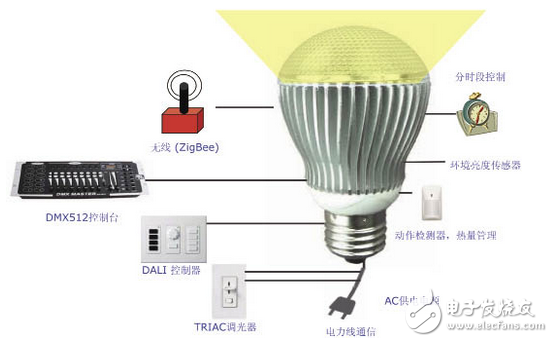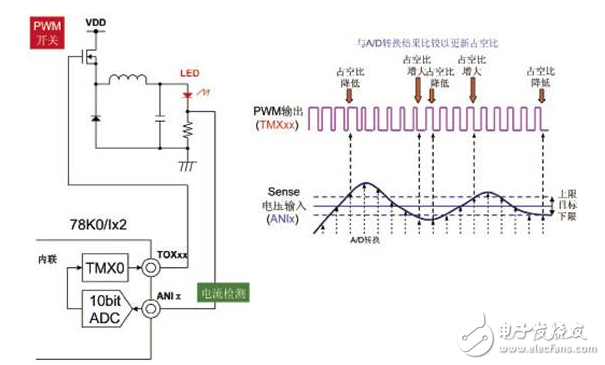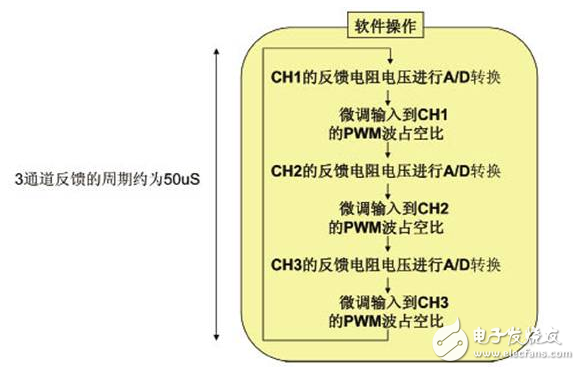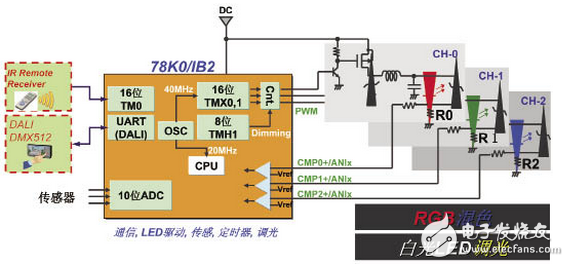Development and trends of lighting technology
Lighting development history
First of all, reviewing the development history of lighting technology, the first generation is represented by incandescent lamps. The advantage is that the price is cheap, the low-temperature starting characteristics are good, but the life is short and the luminous efficiency is low. The second generation is represented by fluorescent lamps, with long life, high luminous efficiency and low cost. The disadvantage is that it contains heavy metal mercury and the ballast/starter consumes a lot of power. The third generation is represented by a high-pressure gas source, which has the advantages of high penetrability and high reflectivity. However, it contains heavy metal mercury, has low color rendering, and requires a rectifier. LED is a fourth-generation lighting equipment, which has low working voltage, safety and energy saving, low maintenance cost and long service life. The main problem at present is that the price is high and the heat is large. It should be pointed out that the recovery of metal mercury in the lamps is currently not available. The manufacturer corresponds, but the LED does not contain mercury.
Lighting market trends
Lighting accounts for a large proportion of household/commercial power consumption, about 17%, and a large amount of consumption causes waste of resources, carbon dioxide emissions, and global warming. Therefore, on a global scale, the demand for green and energy-saving lighting systems is gradually increasing. With the development and improvement of lighting sources, the lighting power consumption is gradually reduced, and the power consumption of LEDs is only 1/8 of that of incandescent lamps. At the same time, the lighting system uses various types of communication and sensor intelligent lighting control systems to improve application efficiency.
In 1998, Japan launched the "21st Century Lighting" program, which aims to increase the energy efficiency of lighting by twice as much as conventional fluorescent lamps through LED technology. South Korea, the European Union, and the United States have also proposed their own lighting plans. China has a number of national standards and industry standards related to semiconductor lighting, and the Ministry of Finance is preparing relevant support policies for semiconductor lighting. The pace of government procurement of semiconductor lighting demonstration projects is accelerating.

Figure 1 Future lighting innovation
Modern LED lighting needs for MCU
The general LED lighting market classification can be roughly divided into the following categories: indoor lighting, commercial lighting, automotive lighting, outdoor lighting, traffic signals, entertainment lighting, street lights and electronic display cards, LCD backlights, etc.
With the development of lighting demand and the deepening of energy saving and emission reduction, future lighting innovations can be technologically innovative from the perspectives of time-phase control, ambient brightness sensor, motion sensor, and thermal management.
The market for future lighting innovation has great potential, as shown in Figure 1. Time-division control refers to different brightness levels at different time periods. The ambient brightness sensor can flexibly respond to the brightness of the environment in which the luminaire is located. For example, when the sky is darker than usual, the street light will be turned on earlier. The motion sensor detector means that when there is no activity around the lamp at night, the brightness will be lowered, and when someone is active, the brightness will be adjusted. In addition, modern lighting requires multiple communication methods. In addition to wireless methods, advanced lighting-specific communication protocols such as DALI or DMX512 make the management of lamps more convenient, and power line carrier communication (PLC) has also attracted much attention in recent years.
The development direction of intelligent lighting
The development direction of intelligent lighting presents several development directions: the integration of MCU is improved, the required peripherals are reduced, and it is more environmentally friendly; LED meets the color mood of home scene dimming, and is more humanized; various communication protocols, convenient dimming system Expansion, scalability enhancement; wireless connectivity enables lighting communications to be integrated into smart homes for integration. The popularity of smart homes can promote green and low-carbon life and protect the environment. Intelligent mixed-tone light requires scene lighting that supports wireless communication. The APPLILET HCD tool can easily realize the development and debugging of mixed-tone light, which is very practical.

Figure 2 Feedback control via comparator 
Figure 3 Feedback control via A/D converter 
Figure 4 LED constant current control operation flow chart (LED = 3 channels)
Modern LED lighting requirements
LED lighting requirements include both home lighting and non-domestic.
Household lighting:
(1) Longer working life
(2) low cost and small size
(3) Low power consumption, high efficiency
(4) Compatible with existing systems
Non-domestic lighting:
(1) Low power consumption and high efficiency
(2) Multi-channel (6 channels or more)
(3) PFC control
(4) PLC communication / wireless communication
The demand for the MCU is as follows:
• Precise control of current and extend lamp life
• A variety of protection features to ensure the safety of lamps
• High integration, saving space and cost
• Flexible and precise dimming with less power consumption at the same brightness.
• Simultaneous independent timer threshold output for multiple channels
• Diversified communication methods, support IR / wireless / DALI / DMX512 / PLC /
• Higher operating temperature (85 ° C ~ 105 ° C)
• More practical evaluation plan
Lighting market demand
Comprehensive high-definition precision, low cost, energy saving and must have emergency protection function, summed up as a single-chip MCU to achieve low-cost and high-performance green energy-saving lighting system.
Application of MCU in LED lighting
Renesas Electronics has introduced the corresponding MCU for the MCU needs of the entire lighting market.
78K0/Ix2
For these needs in the lighting market, Renesas Electronics' 78K0/Ix2 MCU products have solved these problems well. There are many corresponding features of the 78K0/Ix2. The PWM output period of the 78K0/Ix2 is 25ns. It has a 16-bit inverter timer and an internal 40MHz operation clock to meet high-precision dimming requirements. The 78K0/Ix2 eliminates the need for peripheral ICs and can be used to reduce costs by PFC control ICs, variable frequency control ICs, and LED driver ICs (LED lighting). The high-impedance output of the timer corresponding to the emergency state is linked with the comparator/external interrupt. Correspondence can achieve "any brightness" to achieve reduced energy consumption by using sensors/communications, which in turn include DALI, DMX, remote controls, and I2C. Lighting ASSP MCU 78K0/Ix2, with a variety of memory capacity and pin count options, corresponding to simple to complex LED lighting applications.

Figure 5 Lighting Reference Scheme 
Figure 6 Intelligent DALI-DMX512 LED scene lighting control
Features of ASSP MCU 78K0/Ix2 for lighting:
• Built-in high-speed crystal oscillator (CPU up to 20MHz)
• High speed 4-channel 16-bit PWM timer (40MHz)
• Built-in on-chip debugging
• Serial communication (UART, I2C, CSI) with built-in DALI (lighting communication) function
• MCU operating temperature up to 105 ° C
• Independent control of up to 4 LEDs
• Can adapt to the use of LED lighting appliances with a lot of heat
• Easy to implement DALI protocol receiving/sending
Features of timers suitable for lighting control:
• Counting clocks up to 40MHz
• With dead time PWM output
• Full/half bridge control available
• 4-channel simultaneous output
• Function to perform emergency stop in conjunction with the comparator
• LED constant current control with A/D converter
• Can be used as a switching signal for LED constant current control or as a dimming brightness control signal
Enhanced simulation features:
• Timer Synchronous A/D Converter
• Built-in 1.2V regulator reference
• 3-channel comparator
• Built-in operational amplifiers, including PGA mode (&TImes; 4/&TImes; 8/&TImes; 16/&TImes; 32), stand-alone mode (using +/-/output pins)
• Can be used for LED constant current control and quick response for feedback operation
• Can be used to detect small signals from sensors to control the brightness of LED lamps
Constant current control
Constant current control has two ways of constant current control.
The first is feedback control through a comparator. The comparator is used to detect the LED current and constant current control is achieved by changing the duty cycle of the PWM output. Independent dimming of each channel (28 levels) can be achieved by changing the comparator's built-in reference voltage, as shown in Figure 2.
The second is feedback control through the A/D converter, using the A/D converter to detect the LED current, and constant current control by changing the duty cycle of the PWM output. Independent dimming of each channel is achieved by changing the target value of the A/D conversion, as shown in Figure 3.
The LED constant current control operation flow chart is shown in Figure 4. As shown in the figure, there are 3 channels of LEDs to be controlled, which is the repeated operation of A/D conversion → PWM output fine adjustment. The software operation process is to perform A/D conversion on the feedback resistor voltage of CH1, fine-tune the PWM wave duty ratio input to CH1, and then perform the same operation on channel 2 and channel 3, and repeat the above process. The entire period of A/D conversion and detection adjustment for the three channels is approximately 50 μs.

Figure 7 78K0 driveless intelligent dimming LED bulb reference board 
Figure 8 78K0/IB2 LED street light scheme
Green LED lighting solutions
Renesas Electronics' lighting reference scheme consists of three parts, which can be dimmed by PC-side GUI. The PC and communication board are connected by USB cable. The scene lighting board and communication board can be realized by infrared, DALI and DMX512. In Renesas Electronics' lighting reference scheme, the AppliletEZ for HCD program can be used to automatically generate tools to implement, compile and burn lighting control programs. The lighting reference scheme is shown in Figure 5.
Advantages of the 78K0/IB2 low cost high brightness LED dimming (toning) control:
• 3-channel independent constant current control (high brightness LED)
• Dimming control, color control
• Communication mode (DALI, DMX512, AD input)
The intelligent DALI-DMX512 LED scene lighting control is shown in Figure 6. 3-channel independent LED dimming (28 levels) is enabled by the comparator internal reference voltage/PWM duty cycle; dimming accuracy is further improved by the 8-bit PWM TMH1 synchronous control.
The 78K0 driveless intelligent dimming LED bulb reference board is shown in Figure 7. Ordinary incandescent lamp consumes a lot of power, and the energy efficiency ratio of dimming is very low. The 78K0 non-drive intelligent dimming LED bulb reference board can realize AC220V without PFC adjustment function; remote control dimming (custom 315M RF); compact PCB Easy to integrate.
The 78K0/IB2 LED street light scheme is shown in Figure 8. AC220V can be realized, with PFC; total drive power is 60W; dimming communication interface can adopt RS485/PLC interface.
development tools
The first step is to generate the device driver using the device-driven auto-generation tool (Applilet2). The second step is to edit the program (integrated development environment) (source program management, editing, tool management) through Project Manager (PM+). The third step of debugging (ID78K0) and simulation is confirmed by MINICUBE2 (simple), IECube, etc. In addition, for mass-produced programming tools, in addition to the tools provided by Renesas Electronics itself, third-party tools can also be supported. Renesas Electronics offers a suite of lighting reference solutions that enable quick access even when first in contact with the MCU.
Question and answer selection
Q: Can LED lighting achieve real-time brightness control or external light control? How to achieve it?
A: Real-time control of brightness can be achieved, and external light control can be achieved by adding a brightness sensor.
Q: In practice, what principles should the lighting design follow?
A: Lighting design should be people-oriented, but we must first consider safety and practicality, as well as illumination requirements, installation methods, maintenance methods, and finally combine humanized ideas. A good lighting design must have the above prerequisites. of.
Q: Please tell us how to implement PFC function in MCU?
A: The current scheme adopts the boost type APFC. The PFC is realized by the built-in comparator and PWM function of the MCU, and no peripheral IC is required.
Q: What about the prospects of LED lighting? How is its development momentum?
Answer: LED lighting has high luminous efficiency, long life, energy saving and environmental protection, and easy to realize intelligent control. Once the price of the LED chip is loose, it will be widely used in the field of decoration and home lighting.
Q: What are the main factors determining the working environment temperature of LED street lamps?
Answer: The ambient temperature of the street lamp is mainly determined by the heat of the LED itself and the size of the casing such as the LED and the heat dissipation capability. The 78K0/Ix2 is a dedicated MCU with a temperature of 105 °C, so it is more suitable for the lighting industry than the general purpose.
Q: Can you compare DALI and DMX512?
A: The DMX transmission speed is 250kbps, which can control 512 nodes, so it is suitable in the case of simple single-point dimming. DALI has a transmission speed of 1200bps and a transmission distance of 300m. It can control 64 individual nodes and 16 groups, so it is suitable for complex scene dimming mode.
Q: What are the implementation methods of the 78K0/Ix2 series MCU for dimming?
A: You can use the Timer to control the PWM output or turn off the dimming, or adjust the comparator or A / D reference voltage to reduce the current through the LED to achieve dimming.
Q: Can the MCU realize real-time control of high-power RGBLED? How is the hardware implemented?
A: The implementation control of RGB dimming can be realized, mainly through dimming and color adjustment through independent control of 3-channel LED. The hardware can use Ix3 to independently control 3 channels of RGB LED lights. The feedback is not the color feedback, but the current feedback of the RGB LEDs of each channel. The brightness is controlled by controlling the current to achieve the purpose of color grading.
Q: What kind of structure can effectively solve the thermal resistance from LED to atmosphere? Is there any practical possibility for air-cooled water cooling and oil cooling?
Answer: At present, the heat dissipation of the lamps is mainly through the heat dissipation of the metal, and it is also seen that the LEDs are cooled by air.
Q: What is the simple, reliable and better way to design the heat dissipation of existing lamps?
Answer: The heat dissipation of the lamp is indeed an important issue. The main reason is to consider the structure heat dissipation when designing the lamp. The power device on the circuit board is equipped with a heat sink, and the device with good temperature characteristics is selected. Renesas Electronics 78k0/Ix2 series MCUs fully consider the environment of lighting applications, temperature range -40 ° C ~ 105 ° C.
Q: Is the 78K0/Ix2 an MCU designed specifically for lighting circuits? Can it be used for other purposes?
A: This series of MCUs is designed for lighting control and focuses on lighting control, but can also be used in other control areas.
Q: Does the 78K0 have an LED constant current driver and a light intensity sensor?
Answer: The constant current control of the 78K0 is mainly realized by the timer output and the comparator feedback. The constant current is realized by controlling the timer duty ratio by the inversion time point of the LED feedback current detection of the comparator. This chip does not have a built-in light intensity sensor, which mainly achieves stable illumination of the LED through constant current control.
Q: Is the mixed-tone light multi-channel control? What parameters need to be tested?
A: It is multi-channel control. In addition to the necessary constant current control and dimming control, in practical applications, it is also possible to detect the color mixing effect by adding red, green and blue three-color sensors, and increase the temperature sensor to detect the ambient temperature. The Ix2 has multiple 10-bit A/Ds that can be connected to multiple sensors.
Q: When using PWM dimming and monitoring constant current control with AD, how do you understand that PWM is basically constant?
A: The PWM adjusts the duty cycle based on the feedback from the comparator and is therefore not constant. The currents at the same voltage of different LEDs are different. Since the LED illumination is determined by the magnitude of the forward current, it needs to be implemented by constant current control instead of constant voltage control. Then, the constant current control can be implemented by AD detection in addition to the comparator feedback. The AD detection can be implemented to detect and adjust the current, but using AD requires more software processing, but the ripple is smaller.
Q: What is the operating current of the main MCU with reference to the DEMO DALI-DMX512 LED? What is the working voltage?
A: The MCU's full-speed operation consumes about 1mA ~ 2mA. At 5V, if the MCU enters STOP mode, the power consumption can drop significantly, about a few μA.
Bimetal Dial Thermometer,Bimetallic Actuated Thermometers,Bi Metal Stem Thermometer,Bimetal Strip Thermometer
Changshu Herun Import & Export Co.,Ltd , https://www.herunchina.com